Industry
Featuring job postings, an applicant tracking system, and professional networking tools, Industry is the exclusive professional network for the service & hospitality industry.
- User Experience Research
- UI Design for Web and iOS
- Design of Marketing Materials
- Front End Development
The Challenge
Businesses in the service and hospitality industry have a hard time accessing their talent pool through existing hiring methods. "Help Wanted" signs rely on candidates walking by the business or word-of-mouth. Craigslist's résumé section is overwhelming and filled with spam, and Craigslist job postings only reach the active, currently-job-seeking fraction of candidates. Other job sites aren't specialized to the service and hospitality industry and miss a big chunk of the talent pool.
Job seekers have to navigate tricky waters too, from the fact that traditional résumés often aren’t the best way to showcase their skills, to a lack of information about the jobs they're applying to. Additionally, LinkedIn and other professional networking sites have not taken hold with the "Industry" crowd, who don't have a centralized place to network online.
My Role
During my time as Industry's Lead UX Designer, I designed a website MVP (minimum viable product), performed competitive analyses and market research, created new mobile app designs, and structured/conducted user interviews covering a variety of task flows. I also helped out with new client and new user onboarding, customer support via Supportkit's live chat Slack interface, and Google Analytics analysis (used for A/B testing). For some projects, I handed off interactive Axure prototypes and/or detailed specifications to our in-house web developer, and for others, I worked on front end development myself.
Read on for the Industry case study, or jump to a stage of the process:
Learning & Discovery
- User Interviews
- Personas
- Competitive Analysis
- Storyboarding
Design Process
- User Story Map
- User Interface Flows
- Paper Prototypes
- Wireframes
- Visual Design
User Interviews
To gain a better understanding of the problem Industry had hired me to help tackle, I chose to start my Discovery phase with user interviews. To ensure I interviewed the right people, I conducted a problem analysis. The Industry team helped me separate our Target Users into broad categories by intent:
- Job Posters
- Job Seekers
- Non-Seeking Networkers
Next, we subdivided those categories into the possible Job Roles:
-
Job Posters
- Management
- Independents looking for partners
-
Job Seekers
- Industry Newcomer
- Industry Employee, looking to transfer horizontally
- Industry Employee, looking to move up vertically
-
Non-Seeking Networkers
- Currently or previously employed, not actively looking for new Industry opportunities
Finally, I flagged each Job Role that had the potential to include a Work Group (group of individual users working together to achieve the same intent) and identified that potential Work Group:
-
Job Posters
- Management:
Solo or Management Team - Independents looking for partners:
Solo or Group
- Management:
-
Job Seekers
- Industry Newcomer:
Solo - Industry Employee, looking to transfer horizontally:
Solo - Industry Employee, looking to move up vertically:
Solo
- Industry Newcomer:
-
Non-Seeking Networkers
- Currently or previously employed, not actively looking for new Industry opportunities:
Solo
- Currently or previously employed, not actively looking for new Industry opportunities:
After defining our target roles and users, I wrote qualification questions for my interviews in order to make sure I was talking to the right people:
-
Job Posters
- Are you involved in job posting and hiring decisions?
-
Job Seekers
- Are you currently looking for a job in the Industry?
-
Non-Seeking Networkers
- Are you currently or were you previously employed within the Industry?
-
Everyone
- Are you willing to commit to a 30 minute interview?
Using the above qualification questions, I found the following set of interviewees:
-
Job Posters
- Management:
2 Solo, 1 Team of 3 - Independents looking for partners:
0
- Management:
-
Job Seekers
- Industry Newcomer:
0 - Industry Employee, looking to transfer horizontally:
1 - Industry Employee, looking to move up vertically:
3
- Industry Newcomer:
-
Non-Seeking Networkers
- Currently or previously employed, not actively looking for new Industry opportunities:
4
- Currently or previously employed, not actively looking for new Industry opportunities:
Limitations:
Due to time constraints, I was not able to find any Industry Newcomers, that is, anyone currently looking for a service + hospitality Industry job who hadn't held one before. However, I was able to ask those who were employed in the Industry about their past experiences, including their experience finding their first job in the Industry.
Interview Process:
I conducted 30-45 minute interviews with each of the respondents. I took paper notes and recorded audio of the interviews with my phone. When possible, the interviews were conducted at the subject's workplace (Yum!). I asked the interviewees about their jobs, their job-finding and/or hiring experiences, and if/how they networked with colleagues. In particular, I asked about job-finding and hiring tools: did they use any? What were their experiences?
Key Insights:
- Everyone I spoke with had experience either browsing for jobs or hiring on Craigslist.
- Those responsible for FoH (Front of House) hiring said that applicants' personality was especially important to them and hard to gauge from job applications.
- Most employees used Instagram for professional networking and Facebook for sharing Industry events.
- Job Posters favor either Batch or Rolling hiring. Batch Hirers wait for all applications that arrive during a period of time (or until a set number are received) before reviewing and comparing candidates against each other. Rolling Hirers prefer to review applications as they come in and compare applicants against an "ideal candidate."
When we post a job, I'll get 10-20 résumés and 3x that in spam.
I saw a Craigslist ad that just said "Barback, $10 + tips, start Wednesday." Like, what?
We hold casting calls so we can get a sense of peoples' personalities.
Personas
To build our user personas, I compiled information from my user interviews and results from surveys conducted before I arrived at Industry, piecing them together to create 3 personas, one for each of our broad Target User categories. The presentation view of Ella, our Job Poster persona, is shown below:
33 • Cafe Manager
Job Poster
I want to hire people that people want to work with.
Ella's Story
Ella has been working at Fig Cafe for 8 years. She started part-time and is now a Cafe Manager. She's responsible for interviewing the Front of House staff and posting job ads.
Tasks & Goals
- Post job ads, sort through applications, and interview candidates.
- Hire people she enjoys working with and customers enjoy interacting with.
Frustrations
- Coping with high turnover of student employees
- Not finding the "right" person the first time
Typical Scenario
After the cafe's lunch rush, Ella sits down in the office to look through the applications of those who responded to Fig Cafe's open job posting. She flips through emails from 15 Craigslist applicants and then remembers the 3 résumés that were left with her cashiers.
Competitive Analysis
I chose categories for the competitive analysis based on insights from the user interviews. The analysis findings were compiled in a keynote presentation which I showed to the Industry team, and parts of which were later synthesized and added to investor presentations. Below is a table summary of the results of the competitive analysis:
| Geographic Reach | Candidate Volume | Personality-Focused | Industry-Targeted? | Time-Convenient | |
|---|---|---|---|---|---|
| In-Person Inquiries | Local | Medium | Yes | Yes | No |
| Word-of-Mouth | varies | Medium | Yes | Yes | Yes |
| Casting Calls | Local | High | Yes | Yes | No |
| Craigslist | Local | High | No | Yes | Yes |
| Local Classifieds | Local | Medium | No | No | Yes |
| Shiftgig | Global | Medium | No | Yes | Yes |
| Restaurant.org | Global | Low | No | Yes | Yes |
| Indeed | Global | Low | No | No | Yes |
| Global | Low | No | No | Yes |
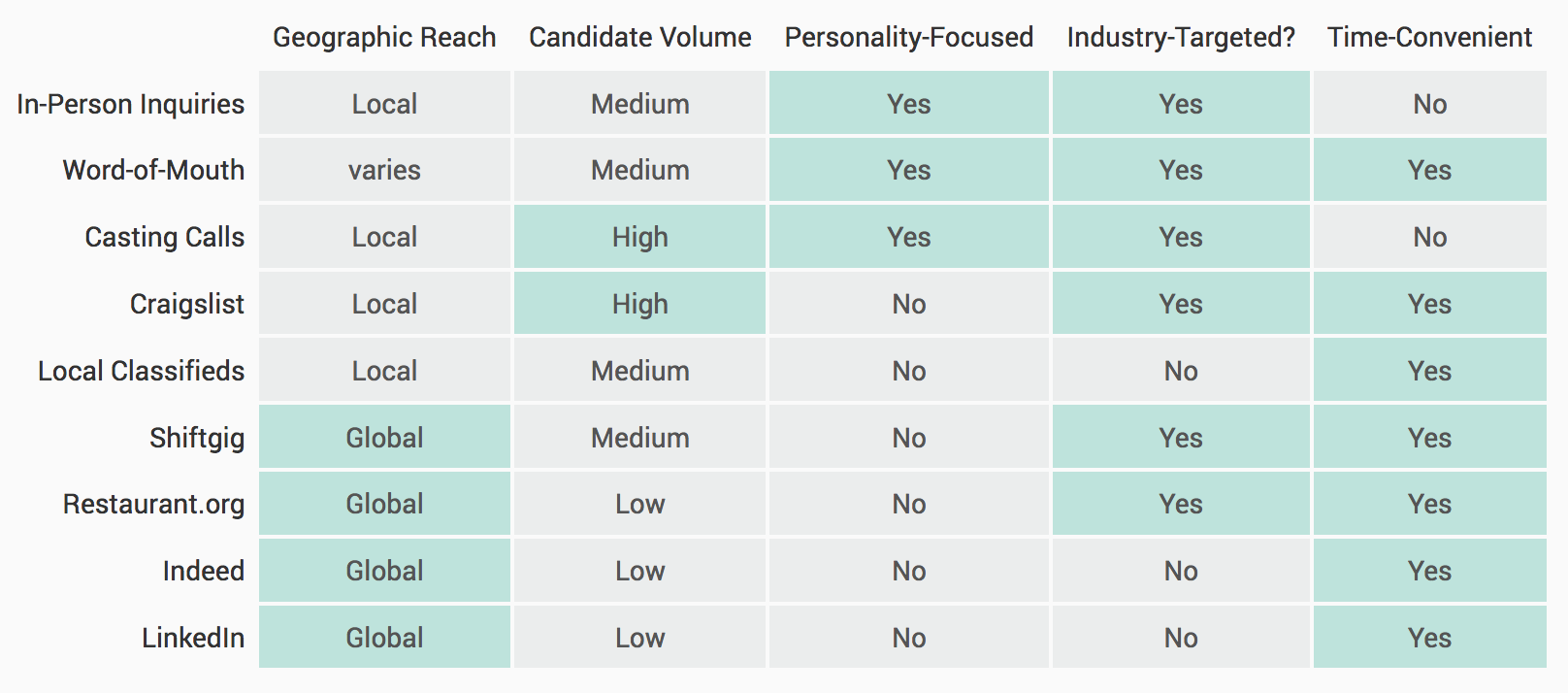
Storyboarding
I drew up storyboards for three key user stories:
- As a Job Seeker, I can find a job on Industry (shown below).
- As a Job Poster, I can post a job opening to Industry.
- As a Job Poster, I can review applications to my job posting.
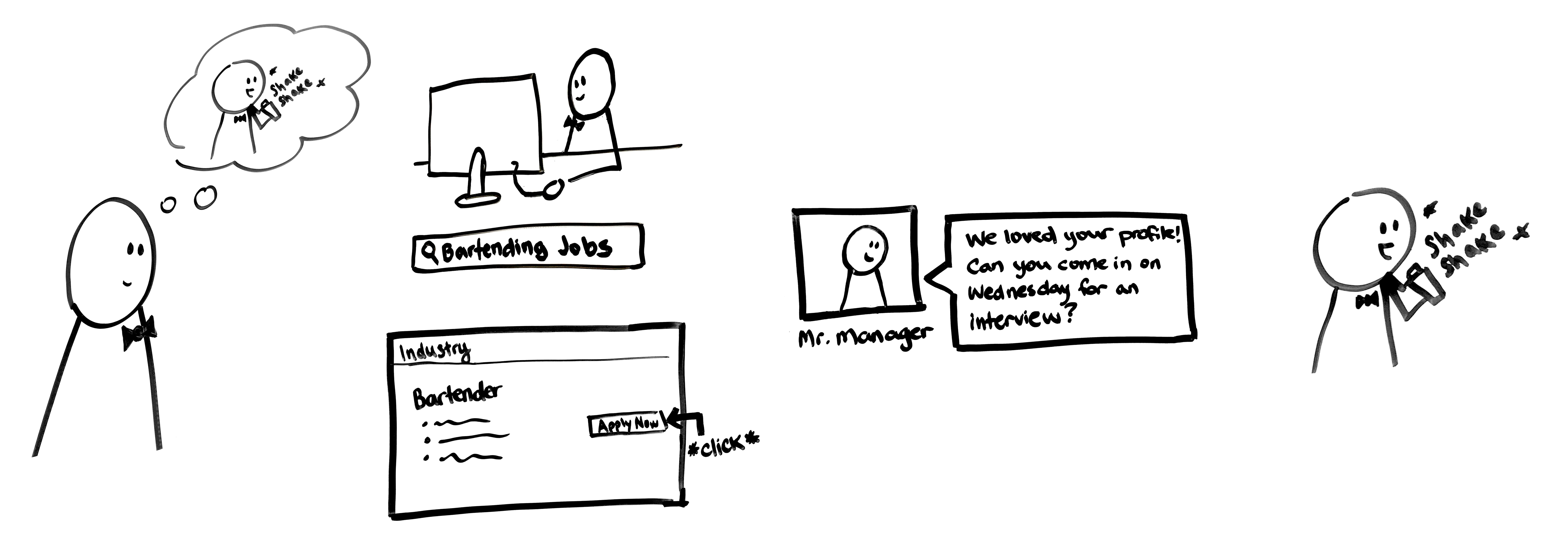
User Story Map
I created an Agile-inspired user story map to map out product features, help us avoid MVP feature creep, and give our team a big picture view. Here's what it looked like initially:
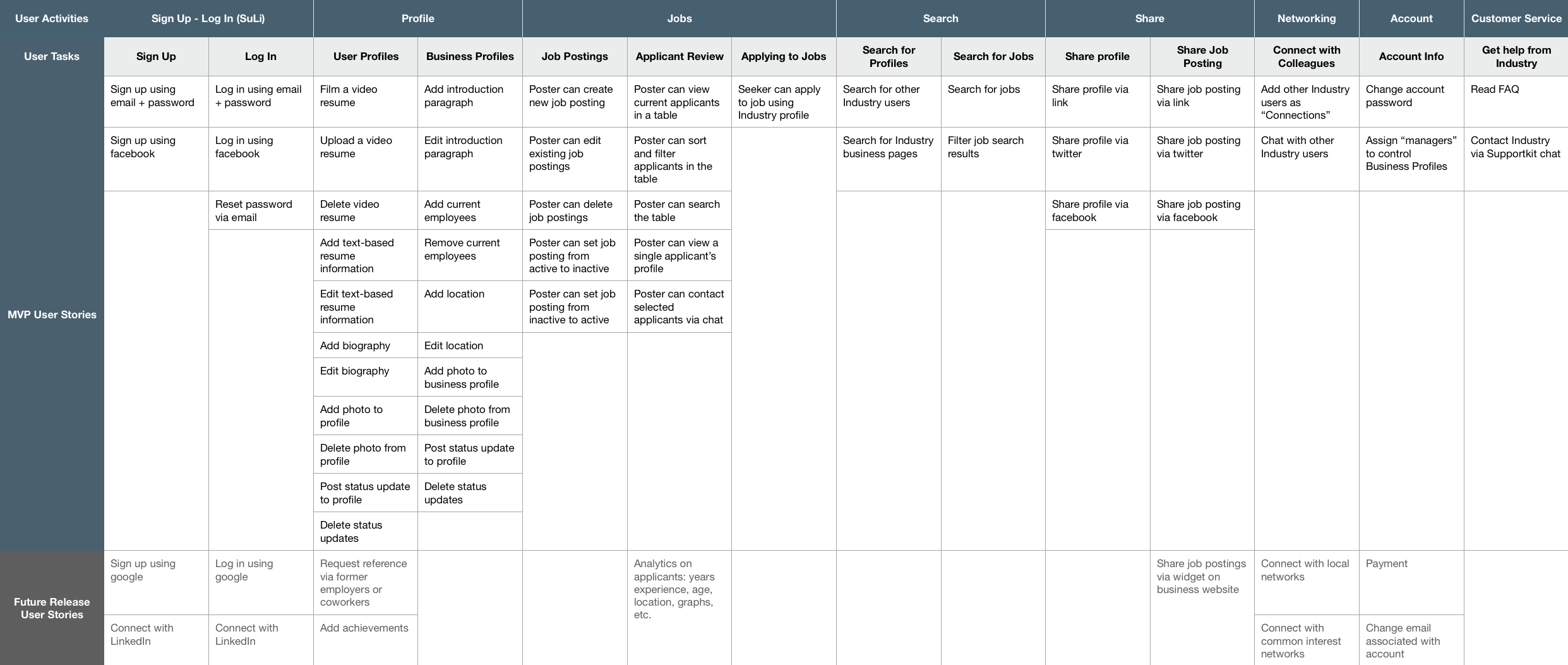
User Interface Flows
For some of the user stories from the user story map, I created flow diagrams showing the interaction between user actions and product state using a UI Flow shorthand from Ryan Singer. Below are two of those flows:
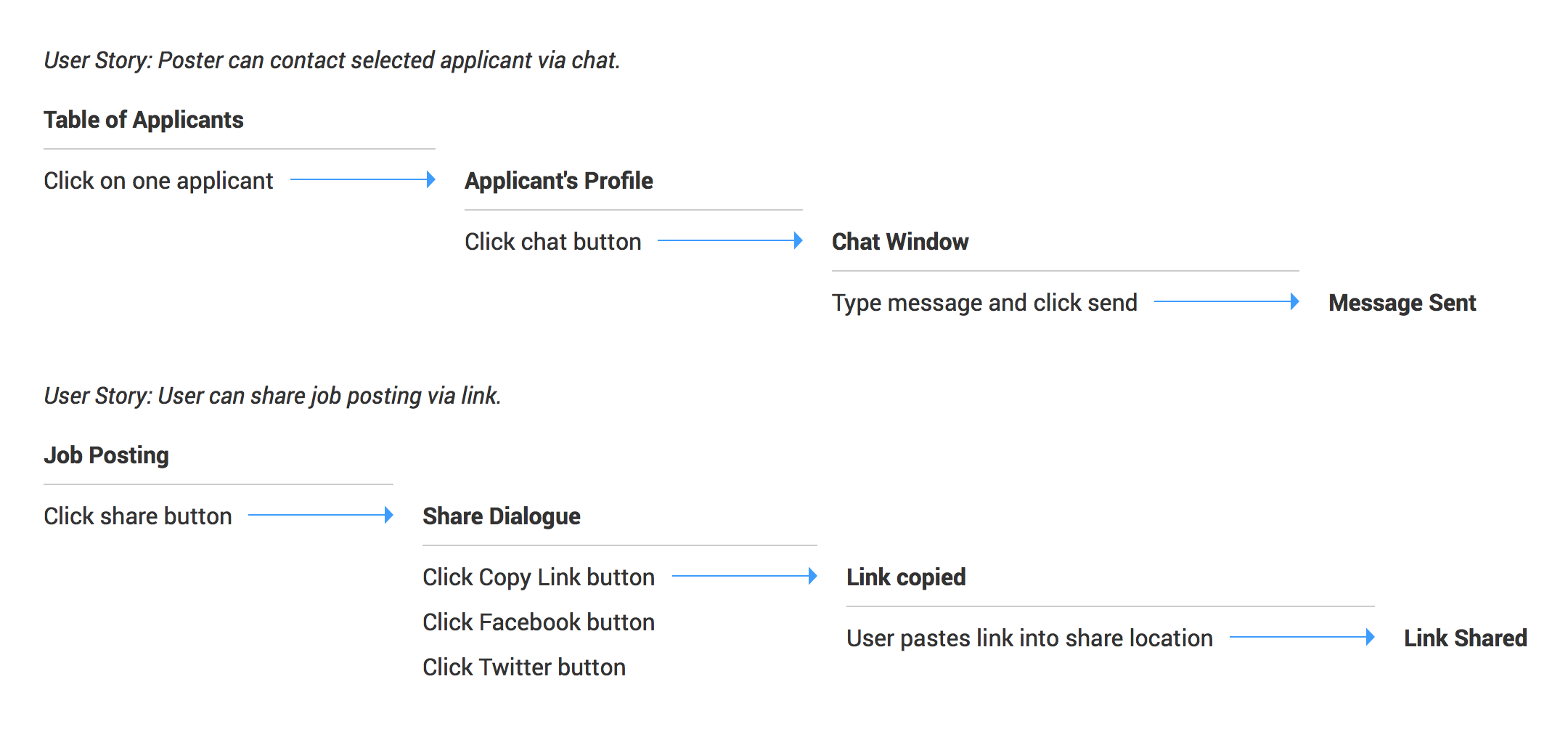
Paper Prototyping
Before creating paper prototypes, I identified some questions I wanted to be able to answer after testing the prototypes with users:
- Would the UI flows we had drawn up lend themselves to task success?
- How would users place information on their profiles? What would they choose to highlight?
Creating the Paper Prototypes:
With those questions in mind, I got out the paper, Sharpies, and scissors. I made two sets of paper prototypes, one for each question:
- In order to test the UI flows, I sketched out a prototype for each screen in the flow.
- To figure out what information users wanted to highlight on their profiles, I created movable cards for each of the profile sections.
Testing the Paper Prototypes:
- To test the UI flows, I utilized scenario-based testing. Based on user "inputs," I manipulated the prototypes to mirror how the website would change.
- To determine placement and hierarchy for the profile information cards, I asked users to organize the profile cards on a profile page background. I also asked them to rank the cards from mostly-to-least likely to be filled out.
Findings from Paper Prototype Testing:
- Job Seekers chose to emphasize their work experience.
- Non-Seeking Networkers placed their Connections higher on the page than Job Seekers and were more likely to want to showcase photos than videos.
- Job Posters wanted to see résumé content (work experience, education, and certifications) first and were interested in applicants' video résumés.
Shown below are two of the paper prototypes, one of a User Profile layout and one of a Job Posting layout:
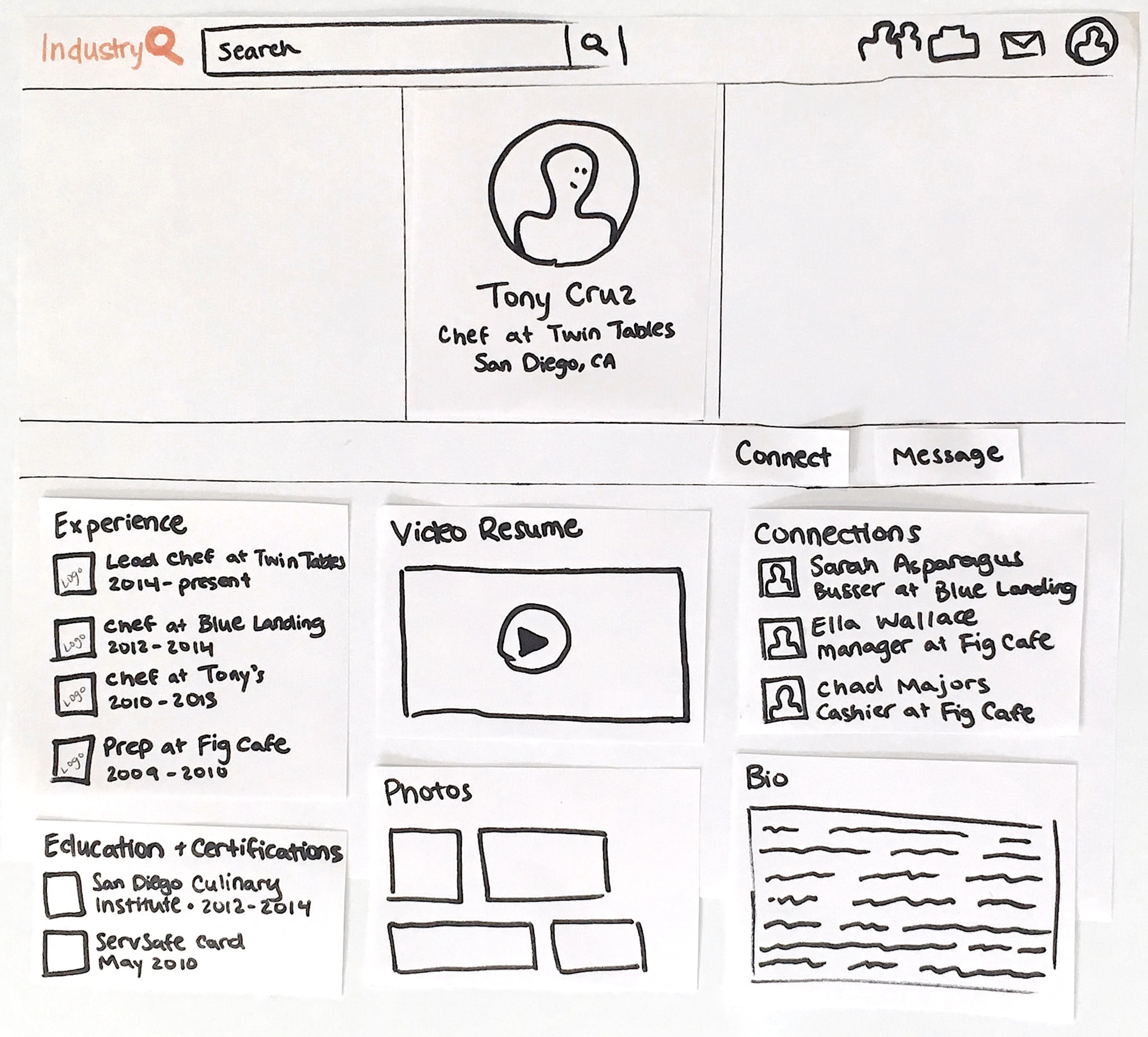
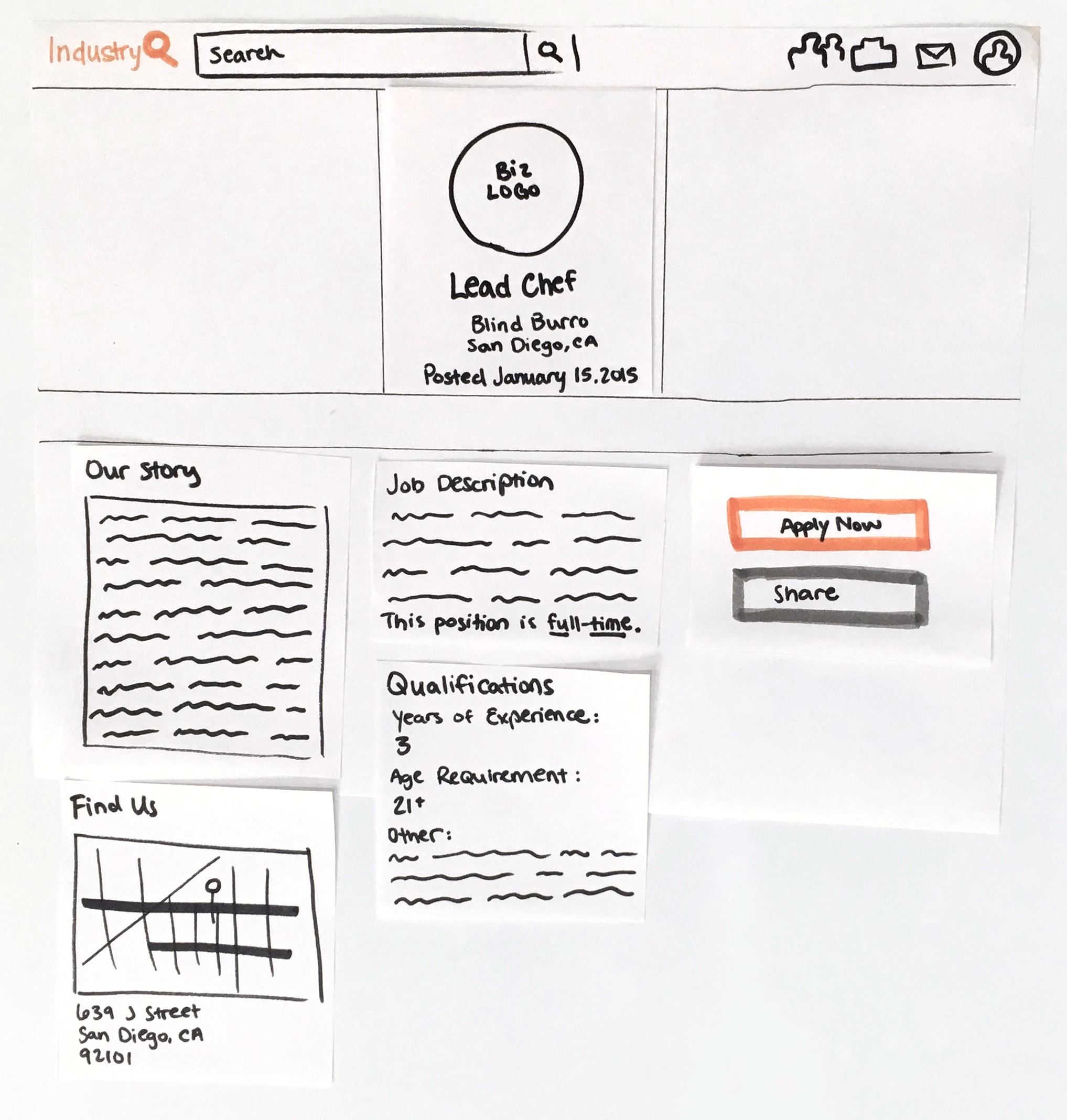
Wireframes
Guided by my qualitative research using the paper prototypes, I created wireframes in Axure. I wanted more feedback on a set of the UI flows, so I used Axure to make the wireframes involved in those flows interactive and used them for further task success testing.
Three wires of a User Profile are shown below, laid out for mobile, tablet, and desktop screen sizes:

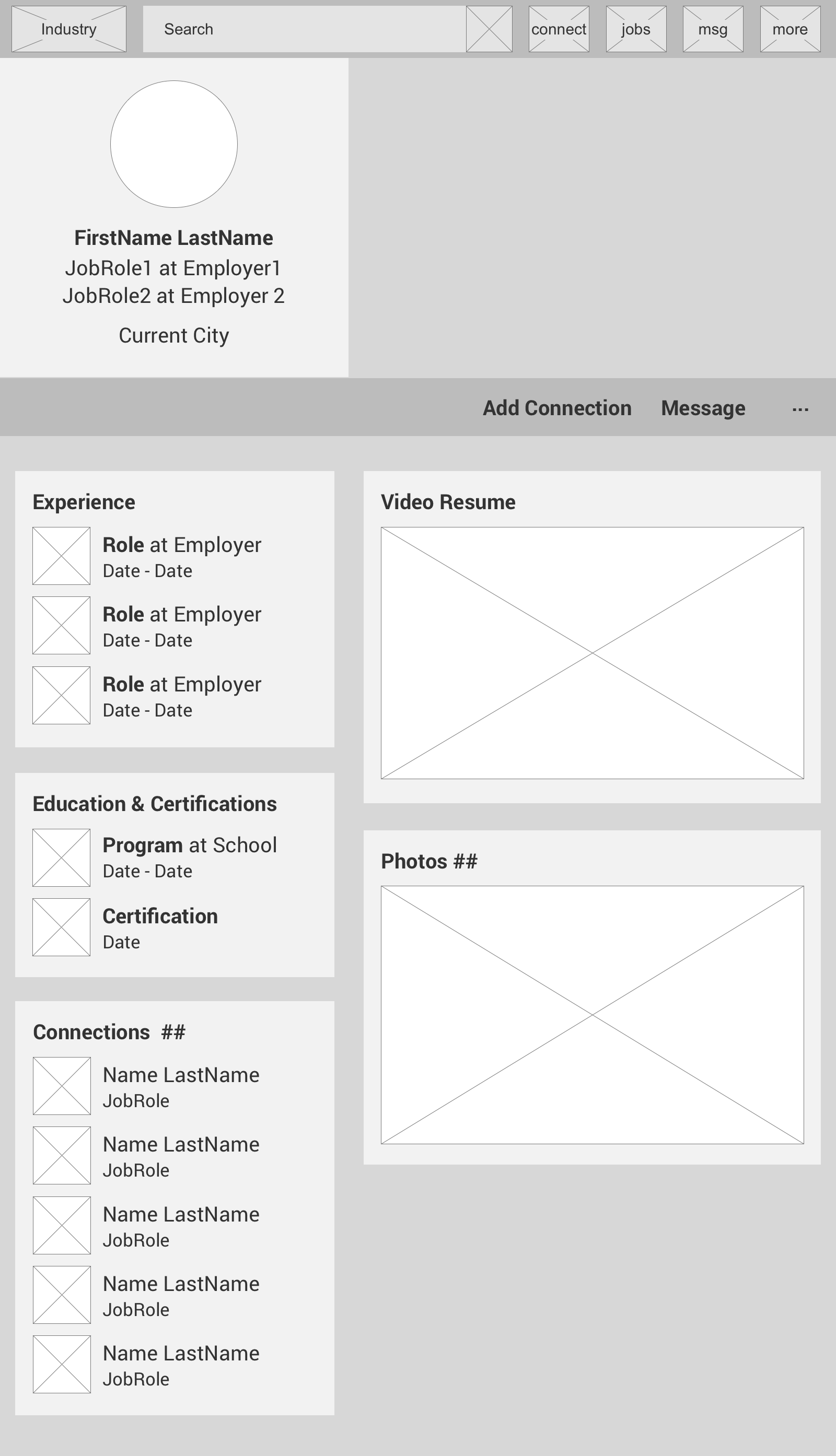
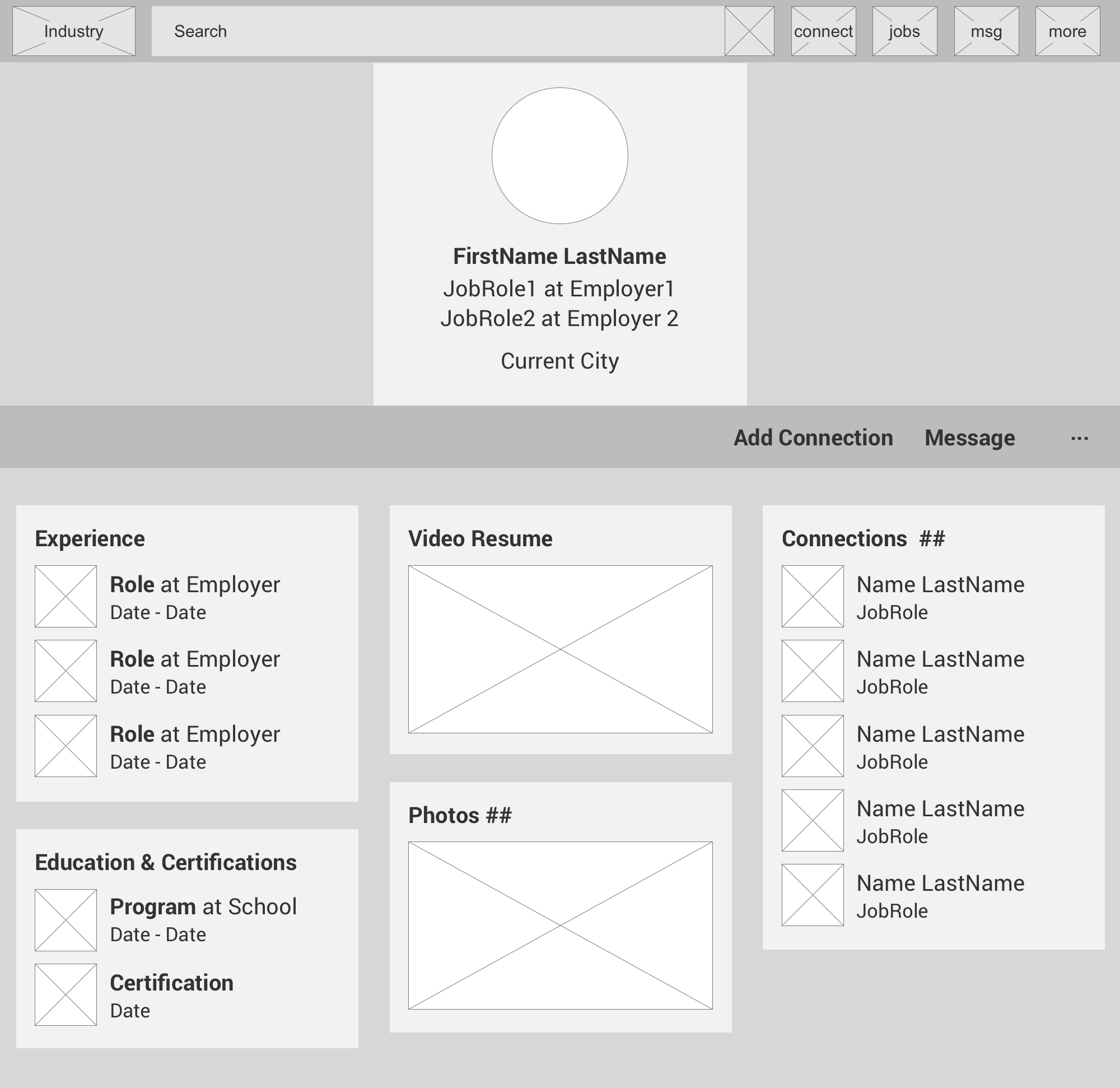
Visual Design
Coming soon.
The MVP I designed was used to acquire an additional $2.3 million in seed round funding. Additionally, 20% of San Diego's ~6,000 restaurants joined Industry, and we helped countless service and hospitality professionals find jobs.
Industry is now operating nationwide at industry.co.
Note: I didn't design the current Industry landing page.
UX Processes
Learning & Discovery
- User interviews
- Persona creation
- Competitive analysis
- Storyboarding
Design
- User story mapping
- UI flow diagramming
- Paper prototyping
- Iterative prototype testing
- Wireframing
- Interactive prototyping
Goals & Signals Tracking
- Task success: jobs posted, jobs applied to, time on task
- Adoption: accounts created
- Engagement: profile updates, referrals
Deliverables
Product Design
- UX reports
- Interactive, high-fidelity prototypes of website and iOS app MVP
- Design specifications
- Modular UI components
Marketing & Company Design
- Company pitch decks
- Flyers and cards
- Industry Stories blog branding
- Press kit assets and organization
- Social media marketing assets
Development
- Front-end development of UI elements on some projects
Technologies & Tools
Product Design
- Axure RP and Axure Share
- Adobe Photoshop
Marketing & Company Design
- Adobe Photoshop, Illustrator
- Keynote, Pages, and Numbers
Development
- HTML & CSS (on a grid framework)
Productivity & Customer Support
- Google Docs, particularly Google Sheets
- Slack
- supportkit's Slack interface
- Trello